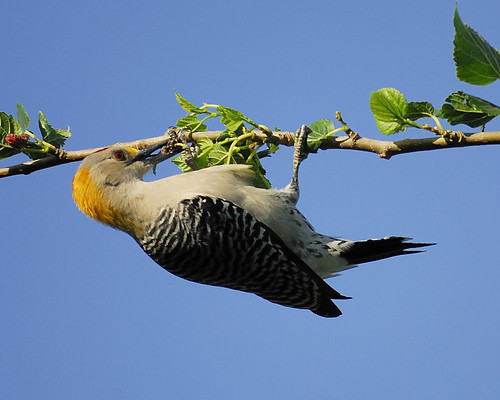tags: Golden-fronted Woodpecker, Melanerpes aurifrons, birds, mystery bird, bird ID quiz
[Mystery bird] Golden-fronted Woodpecker, Melanerpes aurifrons, photographed in Allen Williams Yard, Pharr, Texas. [I will identify this bird for you tomorrow]
Image: Joseph Kennedy, 2 April 2008 [larger view].
Nikon D200, Kowa 883 telescope TSN-PZ camera eyepiece 1/800s f/8.0 at 1000.0mm iso400.
Please name at least one field mark that supports your identification.
Rick Wright, Managing Director of WINGS Birding Tours Worldwide, writes:
I haven't had a chance to test it, but my hunch is that even the most non- of non-birders could tell you that this is a woodpecker. We could go on about the spiky tail, the chisel-like bill, the zygodactyl feet; the pose may not be classically picid, but even way out on its mulberry branchlet, this bird simply screams "woodpecker."
And it was probably screaming, literally, when the photo was taken, too. Some woodpeckers, notably sapsuckers, are quiet and retiring, but this species and its relatives in the genus Melanerpes are anything but.
Let's start at the rear, with that spiky tail. The shape of the rectrices confirms our woodpecker guess, but its color helps us get closer to species: a look at a field guide will show that there are relatively few woodpeckers with solid black tails. The wing-coverts and mantle are evenly barred black and off-white, making this one of the "zebra-backed" species. The nape is extensively yellow (golden, actually), a color that occurs again at the base of the bill; there is a small red crown patch, too. In south Texas, it all adds up to Golden-fronted Woodpecker, a common and conspicuous resident fond of berries.
As usual, there is an interesting caveat to bear in mind when identifying this species. The head pattern of this bird is distinctive in south Texas, but it's important to note that occasional Red-bellied Woodpeckers can show orange or even gold on the head -- it's then that our strategy of starting at the rear pays off, since Red-bellied Woodpeckers have white central tail feathers with dark barring. Always check the tail first when you think you've got an out-of-range Golden-fronted (and there are indications that the species is spreading, so keep eyes and minds open).
More interesting perhaps is the fact that Golden-fronted Woodpecker is one of (one of?) the most geographically variable woodpeckers in the world. In the southern portions of its extensive Middle American range, the bird is smallish and noticeably darker-backed; the central rectrices may be barred, and the golden of the head is replaced by red. I've seen birders dismiss these tropical birds as "Red-bellied Woodpecker," hundreds and thousands of miles out of range as that species would be.


Golden-fronted Woodpecker, due to nape and forehead markings~~~ Male due to red crown
Is this a new one? Usually I see other answers by now!
I agree. The yellow on nape and brow are a giveaway. I can just barely make out a red edge, so I'll say male, too.
Yes, I'd say Golden-Fronted Woodpecker for the above stated markings. Geographic region also correct.